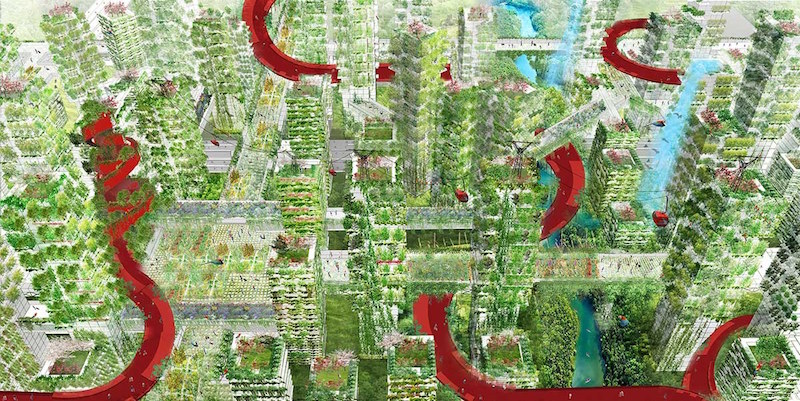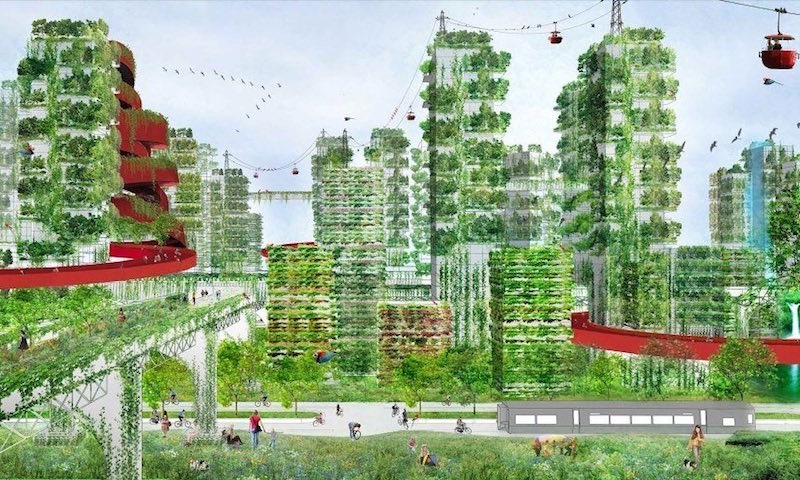Not long ago, Stefano Boeri Architetti announced their plans to create the first ‘vertical forest’ in China. The building would be covered in over 3,000 plants and absorb 25 tons of CO2 per year and produce 60 kilograms of oxygen per day. The goal of the project was to help rectify one of China’s biggest problems: air pollution.
The Nanjing Vertical Forest is a start in creating cleaner air for the country, but its small scale means it can only do so much. An entire city of vertical forests, however, may be able to provide the boost in air quality the country needs. Stefano Boeri Architetti’s new vision for China is to create ‘forest cities’ where every building is a vertical forest, covered in greenery and cleaning the air.
The cities would have the appearance of a post-apocalyptic city in the process of being reclaimed by nature. Only, where the streets of a post-apocalyptic wasteland would be empty and the infrastructure a crumbling mess, these forest cities would be bustling hives of activity, just like any other city.
The first of these sustainable mini-cities would be located in Luizhou, a Chinese city of about 1.5 million people, the Guardian reports. Another of these forest cities is being conceived around Shijiazhuang, a city that is consistently among China’s ten most polluted.
Forest City Shijiazhuang would consist of five districts (petals) each hosting 20,000 residents. Each petal would be a mixed-use environment with residential housing, offices, retail spaces, public spaces, and gardens. The growth of Forest City Shijiazhuang would focus on the vertical space, and reduce urban sprawl.
It is estimated that every square meter of a Vertical Forest façade will absorb 0.4 kilograms of CO2 per year, which means the plants housed in the vertical facades of the buildings will absorb about 1,750 kilograms of CO2 per year collectively, and that isn’t even including the plants located in the parks and gardens.
The vegetation on the outside of the buildings will absorb CO2, but will also help with cooling costs. In the summertime the vegetation will reduce the heating of the facades by up to 30 degrees and create a natural difference in the inside and outside temperature of about three degrees, further adding to the sustainability of the city.
While much of the recent data has pointed toward making cities denser in order to make them more sustainable, Boeri thinks these mini-cities of 100,000 people or fewer and constructed of green architecture are a more sustainable solution than huge, densely populated cities of 10 to 20 million people.
Boeri told the Guardian the firm is already working on designing the different buildings for the forest city proposal. The first forest city could even begin construction by the end of this year and be completed by 2020.
 Image courtesy of Stefano Boeri Architetti.
Image courtesy of Stefano Boeri Architetti.
Related Stories
| Aug 4, 2022
Newer materials for green, resilient building complicate insurance underwriting
Insurers can’t look to years of testing on emerging technology to assess risk.
| Aug 4, 2022
Newer materials for green, resilient building complicate insurance underwriting
Insurers can’t look to years of testing on emerging technology to assess risk.
Sustainability | Aug 4, 2022
To reduce disease and fight climate change, design buildings that breathe
Healthy air quality in buildings improves cognitive function and combats the spread of disease, but its implications for carbon reduction are perhaps the most important benefit.
K-12 Schools | Aug 1, 2022
Achieving a net-zero K-12 facility is a team effort
Designing a net-zero energy building is always a challenge, but renovating an existing school and applying for grants to make the project happen is another challenge entirely.
Codes and Standards | Jul 29, 2022
Few projects and properties are being built beyond code
Clients and architects disagree on how well building to code provides resilience, according to a recent report by the American Institute of Architects (AIA) in partnership with Owens Corning.
Concrete | Jul 26, 2022
Consortium to set standards and create markets for low-carbon concrete
A consortium of construction firms, property developers, and building engineers have pledged to drive down the carbon emissions of concrete.
Green | Jul 26, 2022
Climate tech startup BlocPower looks to electrify, decarbonize the nation's buildings
The New York-based climate technology company electrifies and decarbonizes buildings—more than 1,200 of them so far.
Education Facilities | Jul 26, 2022
Malibu High School gets a new building that balances environment with education
In Malibu, Calif., a city known for beaches, surf, and sun, HMC Architects wanted to give Malibu High School a new building that harmonizes environment and education.
Mixed-Use | Jul 18, 2022
Mixed-use development outside Prague uses a material made from leftover bricks
Outside Prague, the Sugar Factory, a mixed-used residential development with public space, marks the largest project to use the sustainable material Rebetong.
Sustainable Development | Jul 14, 2022
Designing for climate change and inclusion, with CBT Architects' Kishore Varanasi and Devanshi Purohit
Climate change is having a dramatic impact on urban design, in terms of planning, materials, occupant use, location, and the long-term effect of buildings on the environment. Joining BD+C's John Caulfield to discuss this topic are two experts from the Boston-based CBT Architects: Kishore Varanasi, a Principal and director of urban design; and Devanshi Purohit, an Associate Principal.

















